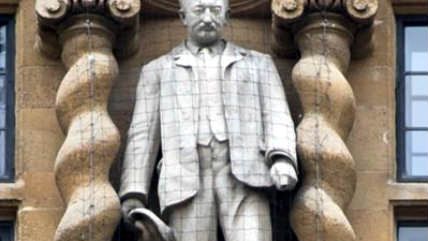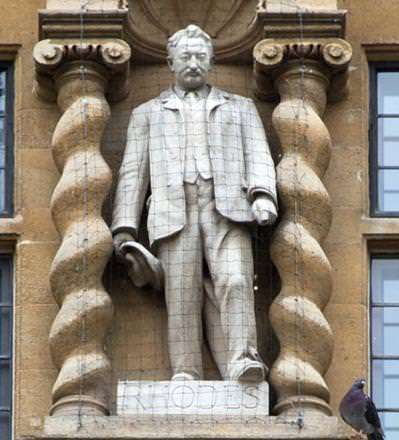College Students Adopt ISIS School of Art Criticism
The attempt to airbrush historical stuff from the present is the height of authoritarianism.


If you thought only the whackjobs of ISIS were hellbent on obliterating statues that offend them, think again. Thousands of miles from the Islamic State, in what you would imagine to be the different moral galaxy of the Western academy, there are young hotheads who likewise want to remove from public view the monuments that have the temerity to upset them.
Last week it was revealed that a bunch of students at Oxford want a statue of Cecil Rhodes removed. Rhodes was a British imperialist, founder of Rhodesia (now Zimbabwe), architect of Apartheid, and all-around unpleasant guy. And according to Oxford students calling themselves the "Rhodes Must Fall" movement, his statue at Oriel College—his alma mater—is not only offensive but an act of violence.
"There's a violence to having to walk past the statue every day," one student told Sky News. The statue is "really problematic."
Problematic is to the intolerant PC brigade what "haram" is to Islamists—it's used to brand things that are wicked, and which should ideally be No Platformed or Safe Spaced out of existence. The activists' casual conflation of speech with violence—or rather, of walking by a statue with feeling assaulted—speaks to the terrifying Orwellianism that has much of the Western student body in its grip.
The notion that expression is a form of violence—whether it's controversial books that are said to assault students' fragile minds or invited speakers whose words allegedly harm students—opens the door to the policing of speech as thoroughly as we police physical force. After all, if walking past a statue is like being punched in the face, or hearing a controversial idea is akin to being stabbed, then that statue must go and that idea must be extinguished, right? Equating thought with violence has been a key tactic of every tyrannical censor in history.
Unlike ISIS, the Oxford students aren't wielding sledgehammers against the stone object of their fury (not yet, anyway). And where ISIS has mainly demolished statues it considers idolatrous, these students are more politically minded demolishers, keen to rid Oxford of the likeness of a racist. And yet, the similarities between these Western statue-fearers and the ISIS statue-destroyers are striking.
The "Rhodes Must Fall" guys talk of Rhodes' problematic "legacy" and how it has no place on a 21st-century campus. One says his statue is "a reminder… of the colonial project." ISIS, too, is also all about erasing legacies. Its English-language magazine Dabiq justified the destruction of artifacts at Mosul Museum in Iraq as a means of "erasing the legacy of a ruined nation." It boasts of having "laid to waste the … legacy of a nation that had long passed from the face of the Earth."
What ISIS and the Oxford lot share in common is a Year Zero attitude, a desire to rewrite history. It's a deeply authoritarian instinct: not merely to discuss the past, and challenge its events and ideas, but to cleanse all remnants of it from the present. It's cultural cleansing, disguised as an Islamic duty by ISIS and as radical anti-racism by Oxford students.
Oxford students aren't the only ones aping the ISIS approach to yesteryear's monuments. They were inspired by students at the University of Cape Town, who protested against and threw shit at a statue of Rhodes until it was taken down last April. In the U.S., students at the University of Texas at Austin (UTA) are agitating for the removal of a statue of Jefferson Davis, president of the Confederacy during the Civil War. A UTA student leader says the statue is "not in line with… the ideals of a diverse and all-inclusive university." Imagine that—a historical monument that fails to conform to the values of today.
Earlier this year, St Louis University took down a statue of the Jesuit Missionary priest Father Pierre-Jean De Smet holding a crucifix over Native Americans. The statue has been there for decades, but it was recently judged "culturally insensitive." Students at the University of Maryland are demanding the renaming of their football stadium, currently named for H.C. Byrd, a segregationist.
In the wake of Charleston church massacre, the Guardian actually set up a page to track all outdated or racist symbols and monuments in the U.S. Seriously. It's like a sex offenders' registery for statues.
If every old thing, whether it's the works of Mark Twain, which are strewn with racial epithets offensive to modern ears, or those libraries named after slave-owner Thomas Jefferson, were to be judged by how well it sits with modern-day mores, we'd have to tear down everything. News Flash: people in the past had different values to ours.
The attempt to airbrush historical stuff from the present is the height of authoritarianism. It's an attempt not merely to control what people can think and say today, but to project contemporary conformism back in time. Yet being surrounded by statues of flawed historical figures and dead eccentric writers is part of living in a complex, colorful society. They're reminders of history's ups and downs, and its changes.
"He who controls the past controls the future," said Orwell. Yes, that's it. The intolerant students and others seeking to smash past images and ideas really have their eye on establishing their future authority to determine what all of us may think and say.


Show Comments (64)